If you’re looking for a desserts treat with a good effort to outcome ratio, may I humbly suggest the loaf pan burnt Basque cheesecake.
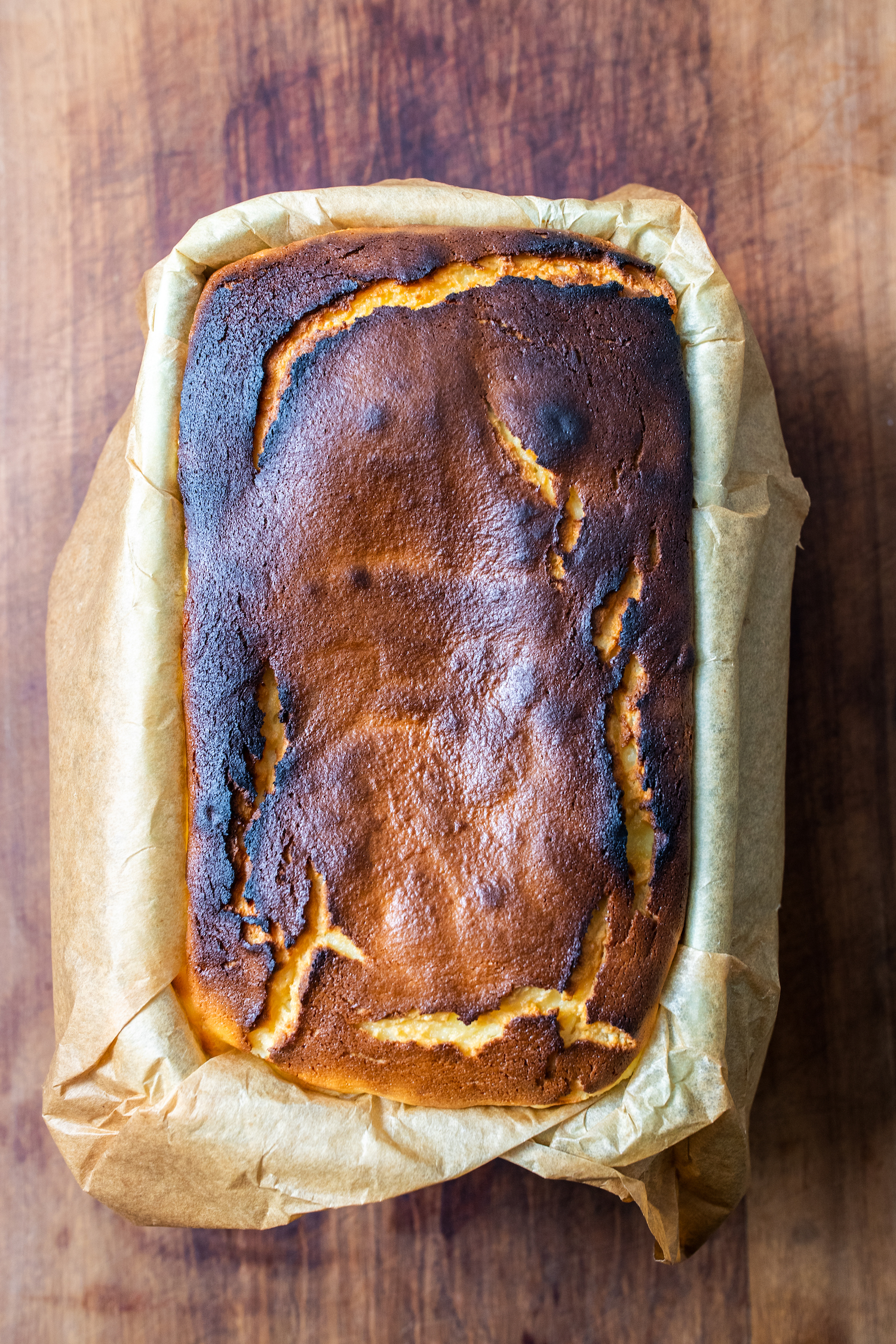
The Basque cheesecake is known for its creamy texture and signature burnt top, making it a favourite amongst anyone that’s tried it. With just a few simple steps and the right ingredients, you can create a scrumptious cheesecake that will impress your family and friends.
I make these fairly regularly at home (maybe once a month) for us to enjoy as and when we feel like it, but don’t let the simplicity fool you; it’s great to serve at a gathering. Especially with the cherry sauce you’ll find in the recipe and video below.
An Introduction to Loaf Pan Basque Cheesecake
What makes the Basque cheesecake so popular (so popular there’s currently a restaurant in London that serves only Basque cheesecake)? I think it’s a mix of the creamy, light cheesecake interior and the burnt top.
This Loaf pan Basque cheesecake is a twist on the classic cheesecake, known for being crustless (and yes, it’s therefore gluten-free). The creamy interior is complemented by a caramelised burnt top, creating a delightful contrast of flavours. What sets this cheesecake apart is its simplicity – it is crafted with just a few high-quality ingredients, allowing the creamy texture to shine through.
“Loaf pan Basque cheesecake is the epitome of indulgence. The creamy filling, paired with the burnt top, creates a perfect harmony of taste and texture.”
Somebody, somewhere that enjoys this dessert
Not only is this cheesecake a treat for the taste buds, but it looks great too. The contrast between the creamy interior and the burnt top gives it such a different look from any cheesecake you might be used to. Whether you’re serving it at a special occasion or enjoying it as a personal treat, loaf pan Basque cheesecake is sure to impress.
But how did this dessert become so trendy?…

The Origin and Popularity of Basque Cheesecake
Basque cheesecake has captured the hearts and taste buds of people around the world. My Turkish neighbour just told me it’s served in every café in Turkey. A new piece of information to me that makes my offer to take over a slice from my next batch more daunting.
The Fascinating History Behind Basque Cheesecake
“Basque cheesecake has its roots in the Basque Country, a region known for its rich culinary traditions.”
The story of Basque cheesecake dates back to the 1990s when it was created by a Japanese chef named Santiago Rivera. Inspired by the traditional Basque-style cheesecake, Santiago crafted a recipe that deviated from the conventional methods of making cheesecake, resulting in a unique and wonderfully textured dessert.
The Basque-style cheesecake originally featured a burnt or caramelised top, a result of the high heat baking technique used in traditional recipes. Santiago’s version embraced this burnt aesthetic, incorporating it as a signature feature. This bold twist on a classic dessert sparked a lowkey culinary revolution and put Basque cheesecake on the map.
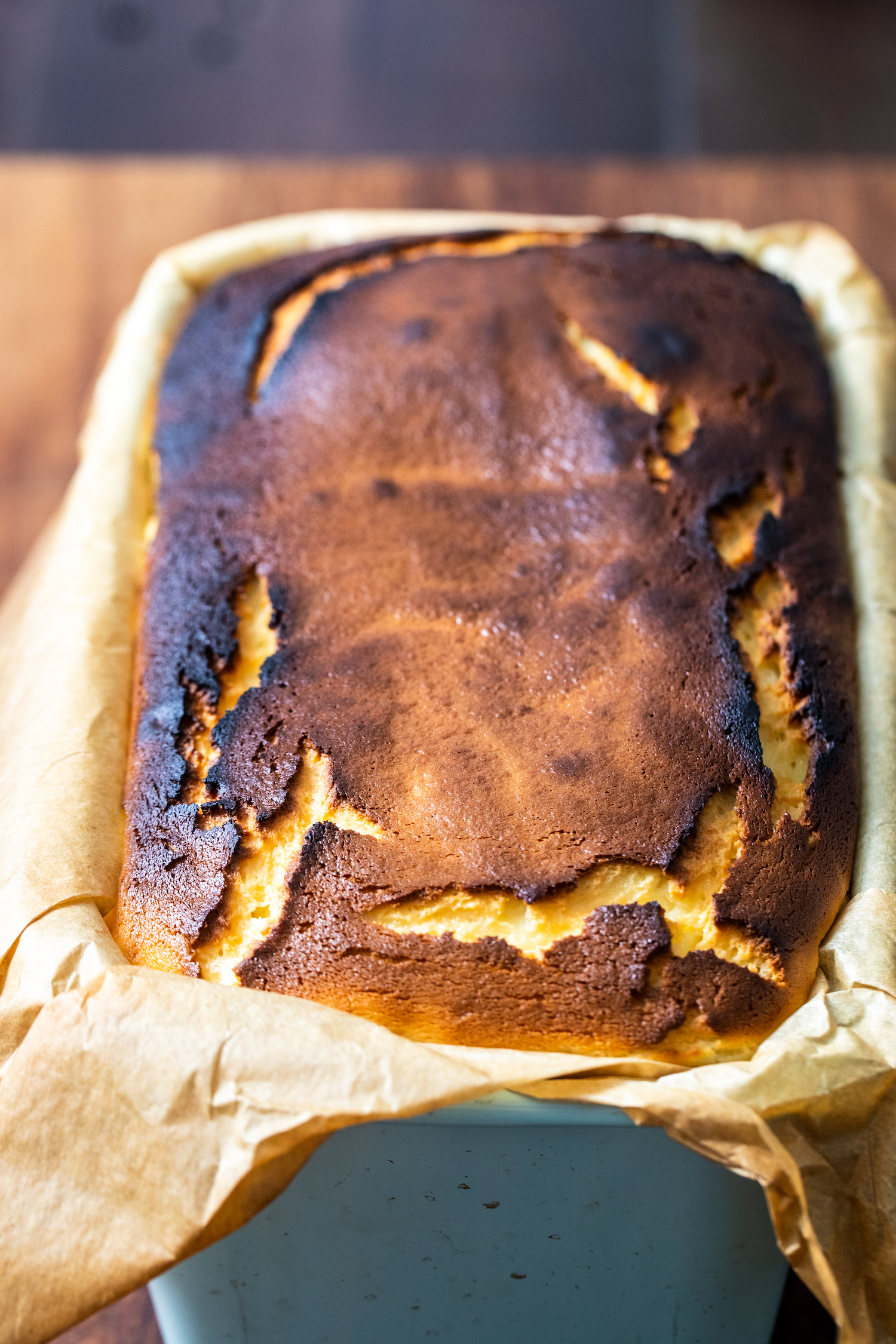
Rise to Culinary Stardom: A Trendy Dessert
Since its creation, Basque cheesecake has risen to become a trendy dessert, popular with home cooks and chefs alike. It’s got middle class dinner party rustic charm written all over it.
And definitely not a cop-out for anyone that struggles to make a regular cheesecake, as someone in my Instagram comments suggested.
Basque cheesecake has gained popularity through word of mouth and social media (hello!), probably because it looks so different and is simple and unique in its technique. From humble origins in the Basque Country, this dessert has now found its way onto the menus of renowned restaurants worldwide, and home cooks have embraced the challenge of recreating this culinary masterpiece in their own kitchens.
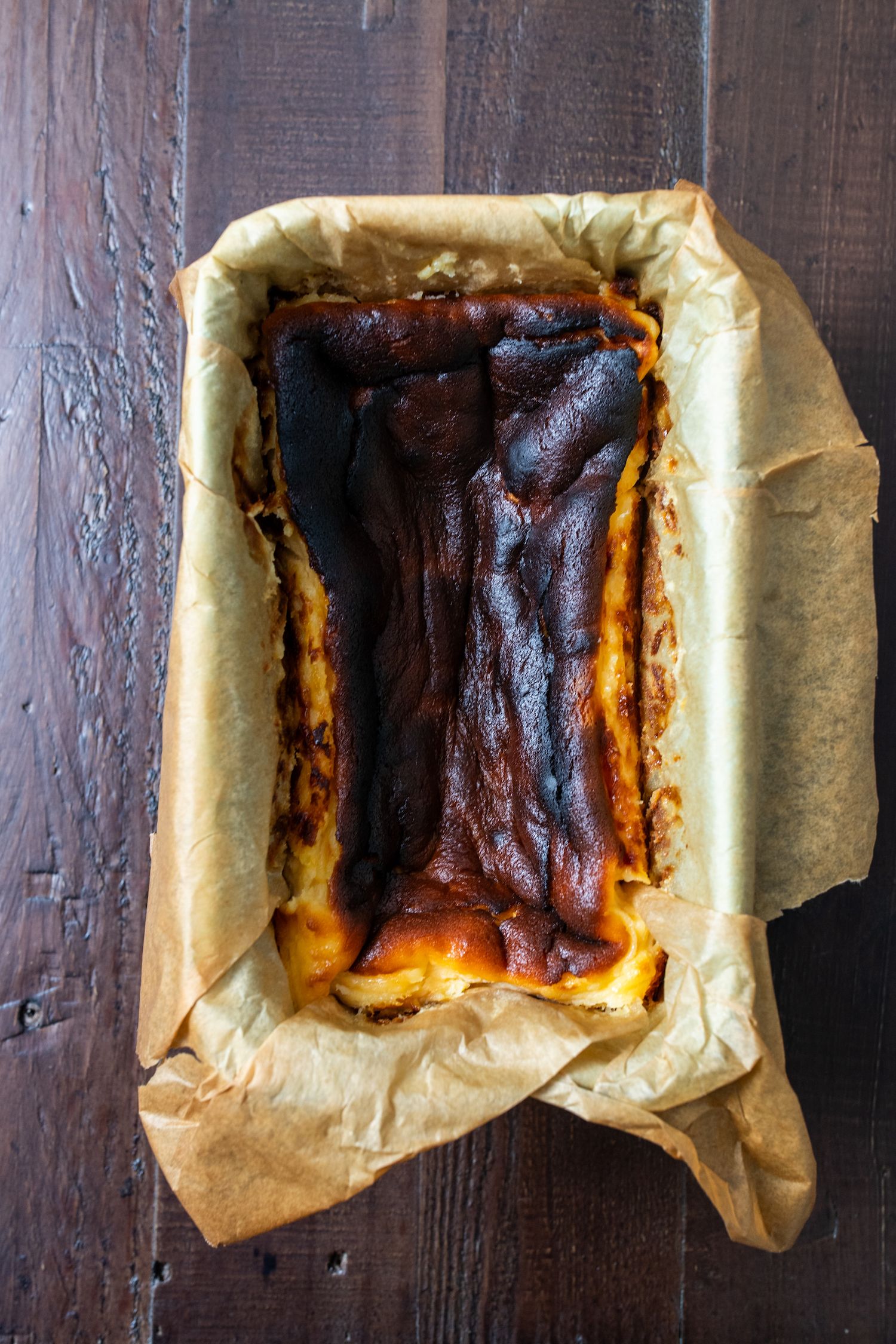
Selecting Your Ingredients for the Perfect Cheesecake
The Importance of Room Temperature Ingredients
It’s really important that your cheesecake ingredients are at room temperature before you get going. Using room temperature ingredients allows for better incorporation, resulting in a smoother and more consistent batter. It also helps to prevent lumps and uneven texture in your cheesecake.
When preparing your ingredients, be sure to take your eggs, cream cheese, and cream out of the refrigerator in advance. Of course, if you’re in the UK like me, you don’t keep your eggs in the fridge anyway. Allowing them to come to room temperature for about 30 minutes to an hour will ensure that they mix together seamlessly, creating a silky and velvety cheesecake.
Choosing the Right Cream Cheese and Cream
Not all cream cheese and cream are created equal, and choosing the right brands can make a significant difference in the taste and texture of your cheesecake. When it comes to cream cheese, opt for a high-quality brand that is smooth, creamy, and rich in flavour. I love Paysan Breton. At the time of writing I think Waitrose Organic is a bit cheaper and also excellent.
Similarly, when selecting cream, go for a heavy or double cream with a high fat content. This will contribute to the lusciousness and indulgent texture of your cheesecake. I use Waitrose Organic Double Cream, but I’d also definitely use a smaller, high quality brand if one’s available.
When I made this at Christmas I used the Waitrose Salted Caramel and Amaretto Double Cream.
| Ingredient | Recommended Brands |
|---|---|
| Cream Cheese |
|
| Cream |
|
By selecting the right cream cheese and cream, you can achieve a perfect balance of richness and creaminess in your cheesecake. Experiment with different brands and find your favourite combination that suits your taste preferences.
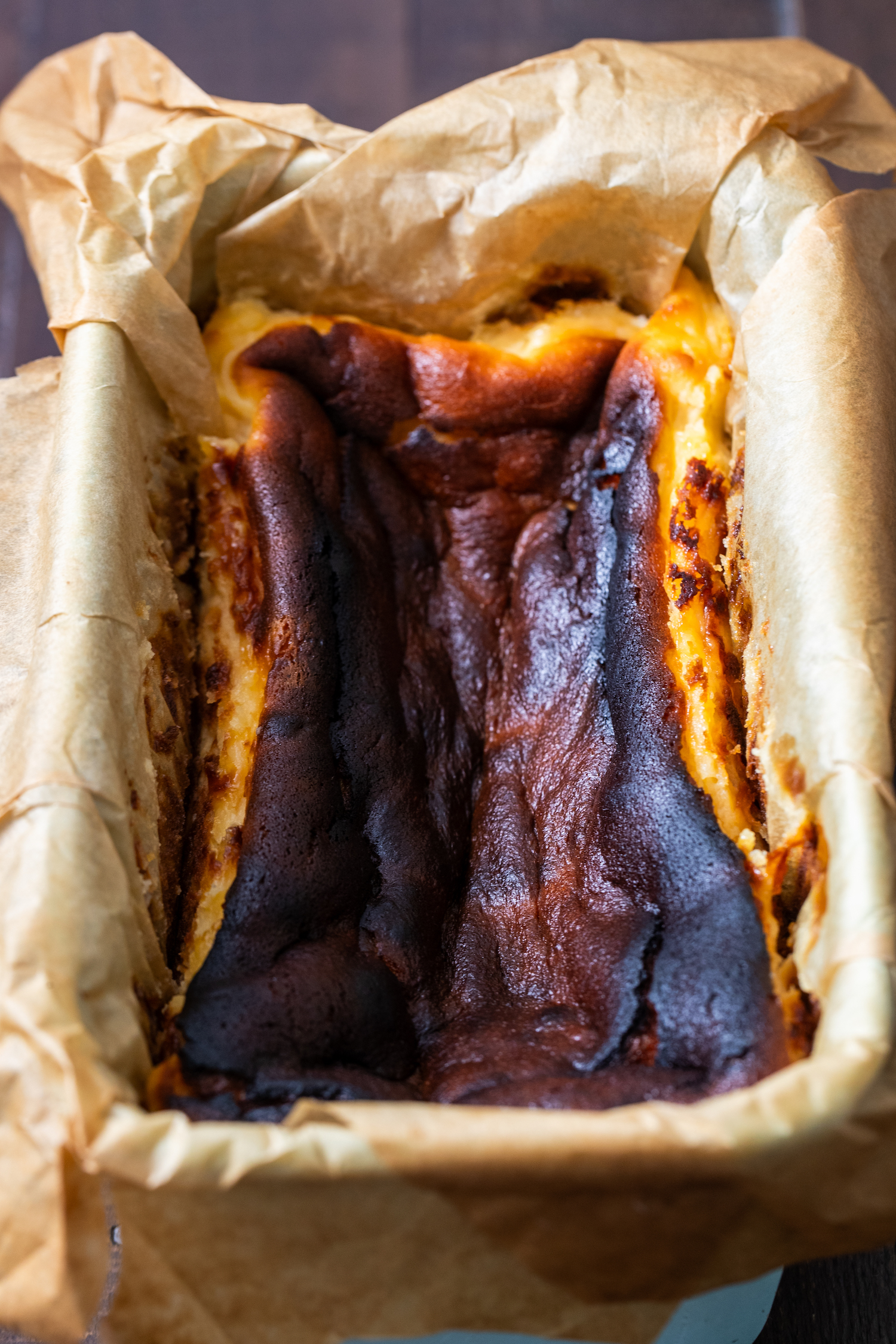
Crafting the Crustless Wonder: Recipe Nuances
A unique feature of the loaf pan Basque cheesecake is its crustless nature, allowing the creamy texture of the cheesecake to take centre stage. However, there are recipe nuances and variations that can further elevate the flavour and presentation of this delightful dessert.
One popular variation is adding a touch of citrus zest, such as lemon or orange, to the cheesecake mixture. The bright and refreshing citrus notes provide a subtle contrast to the rich and creamy base, adding a burst of flavor that complements the overall taste experience.
For those who enjoy a bit of decadence a drizzle of caramel sauce on top of the cheesecake can be a winner. The combination of creamy cheesecake with the sweetness and richness of caramel creates a beautiful combo.
“The loaf pan Basque cheesecake’s crustless wonder allows the creamy texture to shine, while recipe nuances like citrus zest or a chocolate ganache layer can take it to new heights of deliciousness.” – Pastry Chef Sophie Thompson
In terms of presentation, you can get creative with decorative toppings. Fresh berries, such as raspberries or blueberries, add a pop of colour and a burst of freshness to the cheesecake. Edible flowers or a dusting of powdered sugar can also look great if that’s your cup of tea.
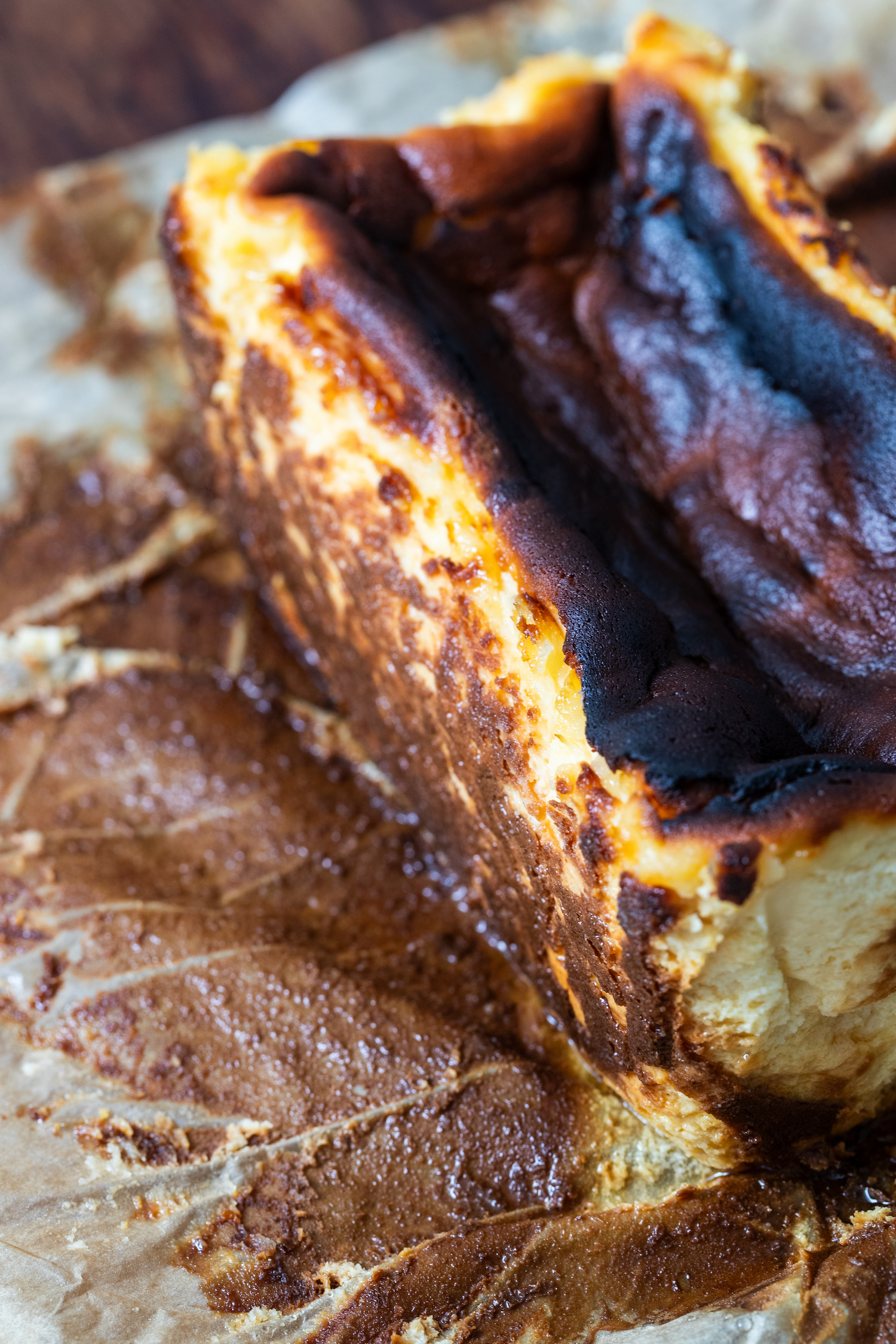
Loaf Pan Basque Cheesecake: The Easy Recipe Guide
Step-by-step Guide to Preparation and Baking
Follow this easy step-by-step guide to prepare and bake a delicious loaf pan Basque cheesecake.
PrintLoaf Pan Basque Cheesecake: Easy Recipe Guide
- Total Time: 1 hour 10 minutes
Ingredients
Cheesecake
- 750g full-fat cream cheese (at room temperature)
- 225g caster sugar
- 15g corn flour
- 3 whole eggs (at room temperature)
- 225ml double cream (at room temperature) (can switch out for flavoured cream)
- 1/4 teaspoon fine sea salt
Cherry Sauce
- 500g frozen cherries
- 1 tbsp lemon juice
- 2 tbsp sugar
Instructions
Cheesecake
- Preheat the oven to 460F/240C.
- Beat the cream cheese and the caster sugar in a bowl with an electric hand mixer.
- Add the 3 eggs one by one and mix until smooth.
- Add 225ml double cream and mix again.
- Finally add the salt and cornstarch and mix.
- Line the loaf pan with parchment and pour in the batter. Tap the tin on the worksurface a few times to get rid of air bubbles.
- Bake uncovered for 40 minutes or until the top is slightly blackened. Do not open the oven door during this time.
- Once the cheesecake is cooled down, transfer it to the fridge.
- Allow it to set overnight before slicing and serving.
Cherry Sauce
- Heat the cherries in a pan for 5 to 10 minutes.
- Add in the lemon juice and sugar.
- Cook for a few minutes then use a stick blender to blend them as smooth as possible.
- Reduce down to desired consistency and finally pass through a sieve into a bowl over ice to cool.
- Prep Time: 30 minutes
- Cook Time: 40 minutes
- Category: Dessert
Expert Tips for a Smooth and Creamy Texture
To ensure your loaf pan Basque cheesecake has the perfect smooth and creamy texture, keep these expert tips in mind:
Tip 1: Use room temperature cream cheese to ensure easy mixing and a smoother batter.
Tip 2: Incorporate the ingredients gradually and mix well after each addition to avoid lumps and create a uniform texture.
Tip 3: Be careful not to over-mix the batter. Stop mixing as soon as the ingredients are well combined to prevent a dense, fluffy or tough cheesecake. We want silky and smooth. I like to also use the electric hand mix on a low speed, so as not to introduce too much air.
Tip 4: Grease the loaf pan thoroughly to prevent sticking and ensure easy removal of the cheesecake after baking. I’ve not found this necessary, but some people swear by it.
Tip 5: Allow the cheesecake to cool completely in the pan before refrigerating. This will help the cheesecake set properly and achieve the desired texture. Refrigerating too soon can make it too chalky.
By following this easy recipe guide and incorporating these expert tips, you’ll be able to create a delicious loaf pan Basque cheesecake with a smooth and creamy texture that is sure to impress your friends and family.
Why the Loaf Pan Makes a Difference
When it comes to baking a Basque cheesecake, the choice of pan can have a significant impact on the outcome of your dessert. While round cake pans are commonly used for cheesecakes, opting for a loaf pan can offer a unique set of benefits that elevate your baking experience. Let’s explore why the loaf pan makes a difference.
Benefits of Baking Cheesecake in a Loaf Pan
1. Even Baking: The rectangular shape of a loaf pan promotes even heat distribution, allowing the cheesecake to cook uniformly. This helps in achieving a consistent texture throughout the dessert.
2. Thicker Cheesecake: The loaf pan’s shape allows for a higher cheesecake profile compared to traditional round pans. This results in a thicker slice of creamy indulgence, perfect for those seeking a more substantial dessert.
3. Easy Slicing: The loaf-shaped cheesecake lends itself well to slicing. You can effortlessly serve beautiful and neat portions, making it an excellent choice for gatherings or when presentation matters.
Adapting Traditional Methods for Modern Kitchens
Adapting traditional cheesecake recipes to suit modern kitchens is another advantage of using a loaf pan. The recipe variations designed for round pans can easily be adjusted for a loaf pan by slightly modifying the quantities and baking time. This adaptability ensures that you can enjoy the deliciousness of Basque cheesecake in your own kitchen.
| Round Pan | Loaf Pan | |
|---|---|---|
| Shape | Round | Rectangular |
| Baking Time | Typically longer | Shorter |
| Slice Thickness | Thinner | Thicker |
| Presentation | Classic | Unique and appealing |
Perfecting the Basque Burn: Baking Techniques
In order to achieve the signature “basque burn” on the top of a loaf pan Basque cheesecake, it’s important to master the right baking techniques. This distinct caramelisation and flavour can elevate the overall aesthetic and taste of the cheesecake.
Here are some baking techniques that can help you perfect the basque burn:
- Preheat the oven to a high temperature, typically around 220°C (425°F), to create an intense heat that will promote caramelization on the surface of the cheesecake.
- Use a dark-colored loaf pan, as it can absorb more heat and contribute to a deeper caramelization on the top.
- Avoid using a water bath while baking the cheesecake, as this can prevent the desired browning effect. Place the loaf pan directly on the oven rack.
- Bake the cheesecake for a longer duration than traditional cheesecakes. This extended baking time allows the sugar in the batter to caramelize and create the prized basque burn.
- Monitor the cheesecake closely towards the end of the baking time to prevent it from burning too much. The perfect basque burn should have a golden-brown color with hints of darker caramelization.
- I’ve found turning off the oven at the end of baking, but leaving the cheesecake in the oven with the door ajar will give it a darker colour without burning too far.
By experimenting with these baking techniques, you can achieve a beautiful basque burn on your loaf pan Basque cheesecake, adding depth and complexity to its overall presentation and flavor.
| Baking Technique | Benefits |
|---|---|
| Preheating the oven to a high temperature | Creates intense heat for caramelization |
| Using a dark-colored loaf pan | Enhances heat absorption for deeper caramelization |
| Avoiding a water bath | Promotes direct heat exposure for browning effect |
| Extending the baking time | Allows sugar to caramelize and create basque burn |
| Monitoring closely towards the end | Prevents excessive burning and achieves desirable color |
The Role of Cornstarch in Achieving Creaminess
When it comes to creating a creamy and luscious texture in a loaf pan Basque cheesecake, cornstarch plays a crucial role. This humble ingredient acts as a thickening agent and binder, contributing to the delightful creaminess that sets this dessert apart. Let’s explore the science behind starch in baking and how you can substitute flour with cornstarch for a lighter and smoother cheesecake.
Understanding the Science of Starch in Baking
Starch, a complex carbohydrate found in plants, undergoes structural changes when exposed to heat and moisture. In baking, starch functions as a gelling agent, forming a gel-like network that contributes to the desired texture. When added to a cheesecake batter, cornstarch absorbs liquid, creating a dense and creamy consistency as it cools.
In the case of a loaf pan Basque cheesecake, cornstarch helps achieve a creamy interior that is velvety and satisfying to the palate.
Substituting Flour with Cornstarch for a Lighter Cheesecake
For those looking for a lighter version of Basque cheesecake, substituting flour with cornstarch is a game-changer. Cornstarch is lower in calories and has a more significant thickening power compared to flour. By using cornstarch as a flour substitute, you can create a cheesecake with a lighter texture while still maintaining its rich and creamy characteristics.
When substituting flour with cornstarch, the general rule of thumb is to use half the amount of cornstarch in relation to the flour measurement. For example, if a recipe calls for 1 cup of flour, you would use 1/2 cup of cornstarch instead.
Experimenting with cornstarch as a substitute for flour in your loaf pan Basque cheesecake recipe can result in a delightful dessert that is both indulgent and light on the palate. Just remember to make this adjustment mindfully, keeping in mind the desired texture and consistency of the cheesecake batter.
If you follow the recipe I’ve given you, you’ll be good to go.
Decoding the Burnt Aesthetic: More Than Just Looks
In the world of dessert aesthetics, the burnt aesthetic of a loaf pan Basque cheesecake is more than just a visual delight. It adds a layer of complexity to the overall taste experience. The unique burnt top of this cheesecake is more than just a charred surface; it contributes to the distinct flavour profile that sets it apart from other cheesecakes.
The Contrast of Bitter and Sweet in Basque Cheesecake
One of the defining features of a loaf pan Basque cheesecake is the contrast of bitter and sweet flavors. The burnt top creates a slightly bitter taste profile that complements the creamy and rich sweetness of the cheesecake base. This interplay of flavors adds depth and complexity to every bite, making it an unforgettable dessert experience.
Burnt Top: A Signature Feature with a Unique Taste
The burnt top of a loaf pan Basque cheesecake is not just for aesthetics; it offers a unique taste that is really unique. I’m struggling to think of any other dessert you’re encouraged to burn. The caramelisation of the surface creates a delicate balance between bitterness and sweetness. This combination of flavours, along with the creamy base, gives the Basque cheesecake its irresistible charm and makes it a standout dessert option.
Serving Your Loaf Pan Basque Cheesecake
You’ll find the outside of the cheesecake quite uneven when you unmould it. This is part of its appeal.
How to Unmould and Serve for Optimal Presentation
Unmoulding your loaf pan Basque cheesecake requires some care to ensure it maintains its integrity and beautiful shape. Follow these steps for optimal results:
- Allow the cheesecake to cool completely in the loaf pan before attempting to unmould it.
- Gently lift the baking paper, being sure the paper doesn’t break in your fingers, resulting in a dropped cheesecake after all that work.
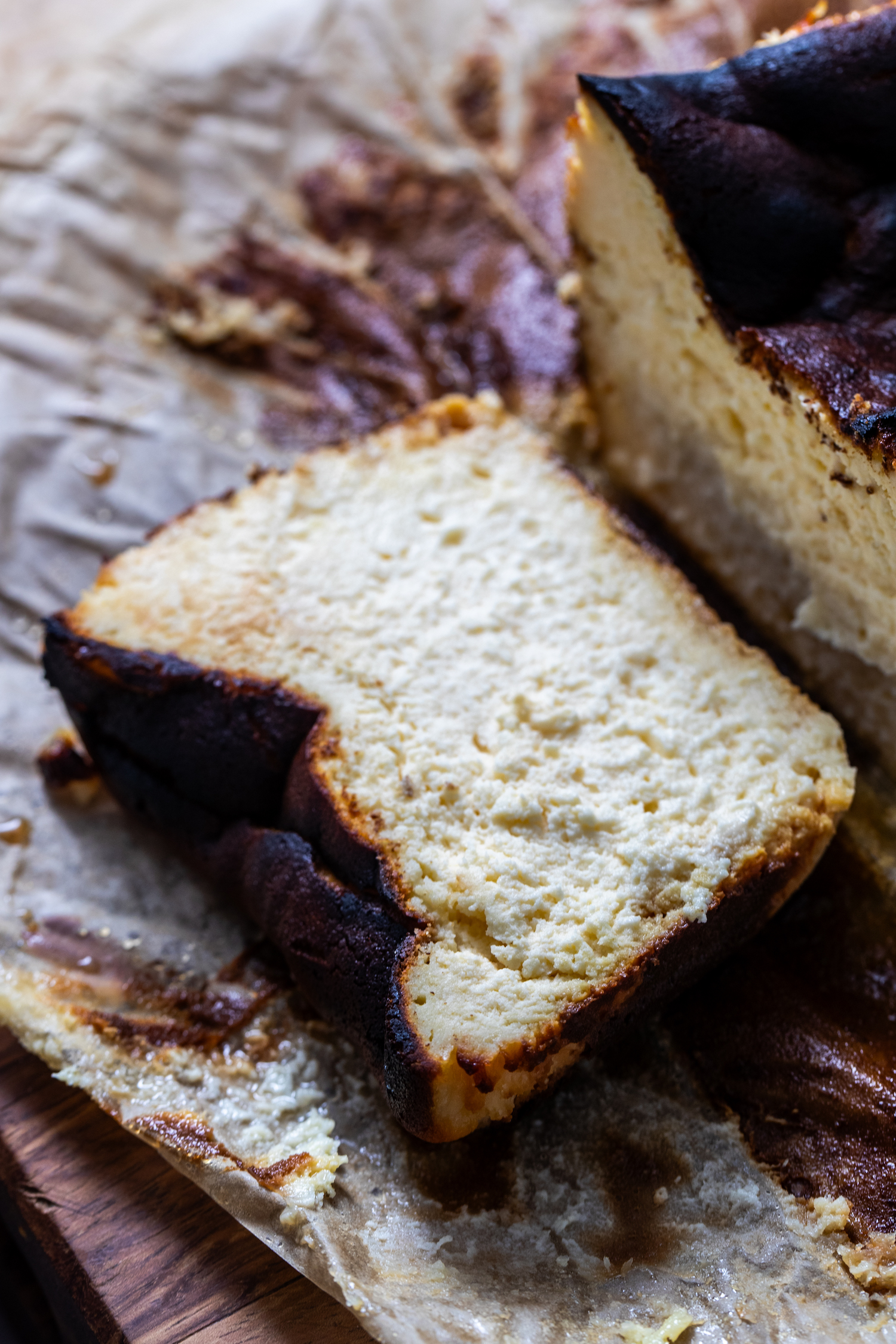
Pairing Suggestions and Garnishing Tips
To complement the delightful flavors of the Basque cheesecake, consider the following pairing suggestions:
- Fresh berries, such as strawberries, raspberries, or blueberries, provide a burst of brightness and acidity that balances the richness of the cheesecake.
- A dusting of powdered sugar adds a touch of elegance and highlights the contrasting colors of the cheesecake.
- Whipped cream or a dollop of crème fraîche provides a creamy and tangy element that harmonizes with the smooth texture of the cheesecake.
- A drizzle of caramel or chocolate sauce enhances the sweetness of the cheesecake and adds a luxurious touch.
- A sprinkle of chopped nuts, such as toasted almonds or pecans, adds a delightful crunch and earthy flavor to the dessert.
When presenting your loaf pan Basque cheesecake, take into consideration the overall aesthetics of the dish. Arrange the garnishes artistically, ensuring that each slice is accompanied by a visually appealing assortment of flavors and textures.
| Garnish | Description | Flavor Profile |
|---|---|---|
| Fresh Berries | Bright and juicy fruits | Acidic, fruity |
| Powdered Sugar | Delicate and sweet | Subtle, sweet |
| Whipped Cream | Light and fluffy cream | Creamy, tangy |
| Caramel Sauce | Smooth and rich sauce | Sweet, buttery |
| Chopped Nuts | Crunchy and nutty | Earthy, textured |
FAQ
What is loaf pan Basque cheesecake?
Loaf pan Basque cheesecake is a delicious dessert known for its creamy texture and burnt top. It is a crustless cheesecake baked in a loaf pan, giving it a unique shape and presentation.
How did Basque cheesecake gain popularity?
Basque cheesecake originated in the Basque region of Spain and quickly gained popularity in the culinary world due to its rich and creamy flavors, as well as its signature burnt top. Dessert enthusiasts around the globe are drawn to the unique taste and texture of this trendy dessert.
What ingredients do I need for a loaf pan Basque cheesecake?
To make a perfect loaf pan Basque cheesecake, you will need cream cheese, sugar, eggs, heavy cream, vanilla extract, and cornstarch. It’s important to use room temperature ingredients for optimal results.
Can I substitute flour for cornstarch in a basque cheesecake?
Yes, you can substitute flour with cornstarch for a lighter and smoother texture. Cornstarch helps create a creamy consistency in the cheesecake, enhancing its velvety mouthfeel.
How do I achieve the perfect “basque burn” on the top of my cheesecake?
To achieve the desired level of caramelization and flavor, you can adjust the baking time and temperature. Experimenting with different techniques such as increasing the temperature towards the end of baking or using a broiler can help you achieve the perfect burnt top.
What are some serving suggestions for loaf pan Basque cheesecake?
To serve loaf pan Basque cheesecake, carefully unmould it from the pan and place it on a serving plate. You can garnish it with fresh berries, a dusting of powdered sugar, or a dollop of whipped cream. Serve it as a standalone dessert or pair it with a scoop of vanilla ice cream for a delightful combination.
